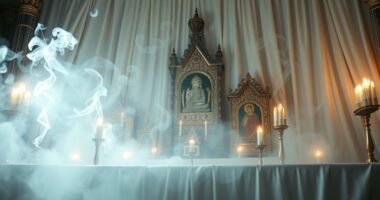Candlelight has been a essential part of human culture, illuminating homes, ceremonies, and spiritual rituals for centuries. It’s more than just light; it symbolizes hope, love, and connection across time and traditions. In medieval times, candles created sacred atmospheres and represented enlightenment. They also foster romantic intimacy and trust in personal relationships. By exploring this history, you’ll discover how candlelight continues to evoke emotion and cultural significance today.
Key Takeaways
- Candles have historically served as vital sources of light, transforming dark spaces into sacred and intimate environments.
- In medieval times, candles symbolized divine presence, purity, and spiritual guidance during religious rituals.
- Candlelight has long represented love, passion, and emotional connection in courtly love traditions and romantic settings.
- Beyond illumination, candles symbolize hope, connection, and spiritual longing across cultures and eras.
- Their flickering glow continues to evoke emotional and symbolic meanings in both religious and cultural contexts today.

Throughout history, candlelight has played a vital role in shaping human culture, serving not just as a source of illumination but also as a symbol of hope, intimacy, and spirituality. During the medieval period, candles were central to many rituals that marked significant life events and spiritual observances. You might imagine how medieval priests and monks relied heavily on candlelight to conduct sacred rites, turning dark chapels into places of awe and reverence. Candles transformed these spaces, creating an atmosphere that connected the physical world with the divine. They were used in countless rituals—from baptism and marriage to prayer and memorial ceremonies—each illuminated by flickering flames that symbolized divine presence and guidance. In these moments, candlelight wasn’t just practical; it carried deep spiritual significance, representing purity, enlightenment, and the soul’s connection to higher powers.
Beyond their religious importance, candles also held romantic symbolism during the medieval era, especially in courtly love traditions. When you picture romantic evenings from this time, it’s often the soft glow of candlelight that sets the mood. Candles became a subtle yet powerful symbol of love and passion, representing a flame that could ignite feelings and forge intimate connections. In medieval literature and art, the candle’s flame often signified devotion, longing, and the fleeting nature of love—its flicker embodying both tenderness and vulnerability. Lovers would exchange candles or light them during secret meetings, emphasizing trust and emotional closeness. The gentle glow created by candlelight fostered a sense of privacy, making moments of intimacy feel even more precious and sacred. Additionally, the use of candles in historical contexts reflects their enduring significance beyond mere illumination — as symbols of hope, connection, and spiritual longing—an enduring symbol that continues to evoke emotion and meaning even today.
Frequently Asked Questions
How Did Candlelight Influence Early Human Social Gatherings?
You see, candlelight shaped early human social gatherings by creating a warm, inviting atmosphere that fostered social bonding. Fire symbolism played a significant role, representing safety and community, helping people feel connected. As you gather around flickering flames, you experience a sense of unity and shared purpose, strengthening bonds. Candlelight’s gentle glow encouraged storytelling, rituals, and conversations, making gatherings more meaningful and memorable.
What Are the Environmental Impacts of Historical Candlemaking Practices?
Like a ripple in a pond, historical candlemaking impacts the environment. You might not realize it, but traditional practices often relied on unsustainable sourcing of materials like animal fat and paraffin, increasing pollution. To reduce environmental harm, embracing sustainable sourcing is key. By adopting eco-friendly methods, you can help minimize pollution, ensuring that the gentle glow of candlelight doesn’t come at the planet’s expense.
How Has Candlelight Been Used in Religious Rituals Across Cultures?
You see candlelight play a crucial role in religious rituals across cultures, where it’s used for meditative lighting and ceremonial symbolism. You might light candles during prayers, festivals, or meditation to create a sacred atmosphere, symbolize spiritual presence, or honor deities. This practice emphasizes reflection and connection, allowing you to partake in shared traditions that use the gentle glow of candles to deepen spiritual experience and mark important rites.
Did Candlelight Play a Role in the Development of Artistic Expression?
Candlelight has truly ignited the flames of artistic expression, shaping masterpieces with its warm glow. It creates an ambient ambiance so enchanting that artists feel inspired to push boundaries and dream beyond the imaginable. You can almost see the sparks of creativity flickering in the shadows, fueling artistic inspiration through centuries of candlelit brilliance. Without candlelight, art might have remained dull and static, forever deprived of its magical, luminous touch.
How Are Modern Technologies Replacing Traditional Candle Illumination?
Modern technologies like LED technology and smart lighting are replacing traditional candle illumination by offering safer, more efficient, and customizable options. You can now control brightness, color, and timing with your smartphone, eliminating fire hazards. LED lights last longer and consume less energy, making them practical for everyday use. Smart lighting creates ambient atmospheres, providing flexibility that candlelight couldn’t easily match, transforming how you illuminate your space.
Conclusion
As you explore the dazzling dance of candles through history, you discover more than just illumination—you uncover a world woven with wonder and tradition. Candlelight’s captivating charm continues to craft cultural connections, igniting imagination and inspiring innovation. Embrace the enduring allure of this ancient art, and let its luminous legacy light your way. Remember, in every flicker lies a story, a symbol, a shining slice of society’s soulful history.









